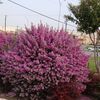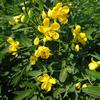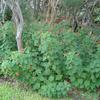
Mortellaro's Nursery
Shrubs, trees, ground covers, native plants, and seasonal color
Wholesale Only
Click on any of the alpha indexes below to view the corresponding lists of plants.
The default list is displayed alphabetically by common name for all plant types. You can view the plants by clicking on the Scientific Name or limit the plant type by using the drop down.
Plants actively being grown for the current season are shown -- selecting Discontinued Items will show plants we have offered in the past.

|
Texas Sage, CompactBotanical Name: Leucophyllum frutescens 'Compacta'
Texas Sage, or Cenizo, is a Texas native shrub that tolerates just about any type or condition of soil as long as excellent drainage is provided; tolerates heat, drought, and salt spray very well. The semi-loose round growth habit can be amended with regular pruning, encouraging a tighter and more uniform growth habit. The silver foliage is moderately pubescent, no more than one inch in length. Purple-pink tubular flowers appear throughout the growing season, primarily after a healthy rain. Cenizo is a superior choice for xeriscaping, but can fit easily into any greenscape. No serious pest or disease issues. [ More Info ]
|

|
Texas Sage, GreencloudBotanical Name: Leucophyllum frutescens 'Greencloud'
Texas Sage, or Cenizo, is a Texas native shrub that tolerates just about any type or condition of soil as long as excellent drainage is provided; tolerates heat, drought, and salt spray very well. The semi-loose round growth habit can be amended with regular pruning, encouraging a tighter and more uniform growth habit. The foliage is moderately pubescent, no more than one inch in length. Purple-pink tubular flowers appear throughout the growing season, primarily after a healthy rain. 'Greencloud' has a slightly faster growth habit over Compact Senisa, and the foliage is grayish-green. Cenizo is a superior choice for xeriscaping, but can fit easily into any greenscape. No notable pest or disease issues. [ More Info ]
|

|
Texas SennaBotanical Name: Senna corymbosa
Texas Senna is a semi-evergreen shrub that provides vibrant yellow flowers from summer into fall. While not a Texas native, this hardy plant performs exceptionally well in USDA Zones 8 to 11, especially in South and Central Texas. It is well-suited to a variety of soil types (alkaline or acidic), including rocky or sandy soils, as long as they are well-drained. Texas Senna is highly drought-tolerant once established, making it ideal for xeriscaping or water-wise gardens. This shrub adds a tropical flair to landscapes with its feathery, dark green foliage and showy blooms. This plant is deer-resistant and non-toxic, making it a safe and low-maintenance option for gardens frequented by wildlife. It thrives in full sun but can tolerate light shade, though less flowers will produce. Texas Senna works beautifully as a focal point in smaller gardens, as a privacy screen, or in mass plantings for a dramatic effect. Its dense foliage and upright growth habit make it a useful backdrop plant or informal hedge. Mature plants typically reach 5 to 6 feet in height and 5 to 6 feet in width. For a full and balanced look, space multiple shrubs 5 to 7 feet apart. Texas Senna’s bright yellow blooms attract a variety of pollinators, including bees and butterflies, enhancing the ecological value of your garden. It can bloom multiple times throughout the growing season, especially with regular pruning after flowering. This plant is also a reliable performer in the intense Texas heat, requiring little supplemental irrigation once established. Winter care for Texas Senna is minimal in warmer regions, where it may remain semi-evergreen. In areas with frost, the shrub may lose its leaves and experience dieback, but it will typically recover from the base in spring. Pruning damaged or dead branches after the last frost encourages healthy new growth. Applying mulch around the base can protect the roots during colder months and help retain moisture in the soil. [ More Info ]
|

|
Turk's CapBotanical Name: Malvaviscus arboreus 'Big Mama'
Big Mama Turk’s Cap is a striking herbaceous perennial that brings a tropical vibe to Texas landscapes. Known for its large, showy red blooms that resemble a partially opened hibiscus flower, 'Big Mama' is a magnet for hummingbirds, butterflies, and other pollinators. Thriving in USDA Zones 7 to 10, it performs well across much of Texas, tolerating both heat and humidity. Turks’s Cap is well-adapted to the state’s climate and thrives in part shade to full shade, though it can tolerate morning sun if protected from the harsh afternoon heat. This versatile plant tolerates a variety of soil types, including clay or sandy soils, and prefers slightly acidic to neutral soils. 'Big Mama' grows larger and more vigorously than other Turk’s Cap varieties, reaching a mature height of 4 to 6 feet and spreading 3 to 5 feet wide. It is an excellent choice for shaded borders, woodland gardens, or as an understory plant beneath trees. It also works beautifully as a mass planting, providing a lush, tropical effect with its dark green foliage and continuous summer-to-fall blooms. For best results in grouping, space plants 3 to 4 feet apart. This plant is non-toxic and deer-tolerant, making it ideal for wildlife-friendly and low-maintenance gardens. When compared to Texas Native, Malvaviscus arboreus var. drummondii, 'Big Mama' stands out for its larger blooms and more robust growth habit. While both are well-suited to Texas landscapes, 'Big Mama' offers a more dramatic floral display and a slightly larger overall size, making it a bolder choice for focal points or dense plantings. Winter care for Turk’s Cap 'Big Mama' is straightforward. In most parts of Texas, it will die back to the ground after the first frost but will reliably return in spring. Mulching the base with 2 to 3 inches of organic material helps insulate the roots during colder months and conserve moisture. In frost-free areas, it may remain evergreen and require only minimal cleanup of older foliage in late winter. [ More Info ]
|
